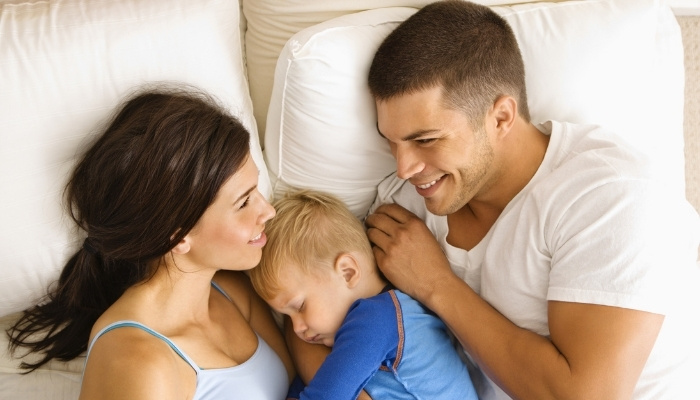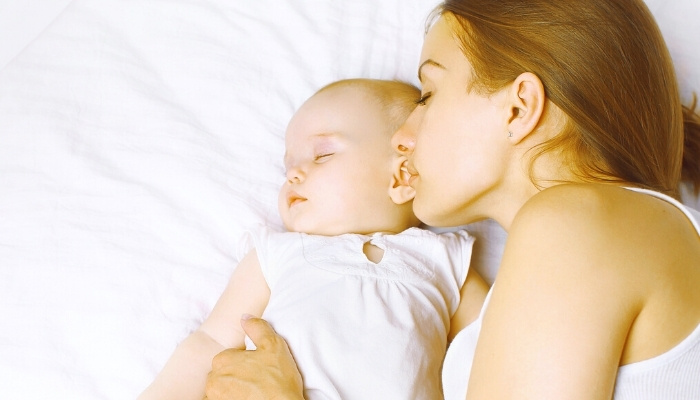Having a baby can impact your sleep in a significant way. You may encounter various suggestions such as sleep training, sleep techniques, and co-sleeping to improve the quality of sleep for both you and your baby.
It’s important to know which recommendations are safe and which ones you should definitely skip.
Is co-sleeping safe? Co-sleeping is not advised for children under the age of one due to safety concerns. However, many parents do choose to co-sleep and take safety precautions. Though your baby should be in your room sleeping for the first six months of life, it’s still not recommended that they share your bed.
Parents have to decide what works best to ensure their baby is safe while also getting rest. You should know everything about the benefits and risks of co-sleeping before making any decisions.
Co-Sleeping With Your Baby – What To Know First
It’s important to know exactly how co-sleeping is defined before you decide if you are for or against it as a practice.
What Is Co-Sleeping?
Co-sleeping occurs when a parent and child sleep in the same area close enough for each of them to be aware of the other.
This can be a bassinet hooked onto a parent’s bed. The baby is technically in his own space, but he is close enough for mom to touch. The term is also often used to refer to room-sharing or bed-sharing.
Bed-sharing means a baby and parent sleep on the same surface, whether it’s a mattress, couch, or recliner. This is not recommended.
Though co-sleeping and bed-sharing may sound like the same thing, there are small differences.
Co-Sleeping Pros and Cons
Co-sleeping appeals to some parents because there are pros. However, the cons and safety concerns can outweigh them.
Benefits of Co-Sleeping
Co-sleeping makes breastfeeding easier for mom and baby. It allows both to rest while ensuring the baby still gets the food he needs each night.
Some babies also just sleep better when they are near a parent. They cry less and settle down once they sense a parent is near.
Dangers of Co-Sleeping
Co-sleeping, especially if done improperly, increases the risk of SIDs and can lead to suffocation.
Your baby can get pressed up against your body, and they aren’t able to turn over in those first months of life. This can make co-sleeping and bed sharing extremely risky.
Psychological Effects of Co-Sleeping
Though it does seem to depend on the age your child is when you co-sleep, there is an increased risk for certain behavioral issues in children who co-sleep when little.
You may not see these issues until your child is nearing adolescence, but they can include depression, attention issues, and anxiety.
Is Co-Sleeping Illegal?
Co-sleeping is not illegal, but if your child is injured or dies while co-sleeping, you may still be held responsible and criminally charged, particularly if you were under the influence of drugs or alcohol.
Co-Sleeping With Newborn
Newborns sleep a lot, but they don’t do it all at the same time. This can leave you exhausted and looking for any way to rest.
Co-Sleeping With Newborn on Chest
When your newborn baby is snuggled against your chest getting some skin-to-skin time, expect him to fall asleep. However, you don’t need to fall asleep.
It’s fine for your infant to rest in this position as long as you are awake and paying attention to the baby.
The problem is that it’s very hard to stay awake when the warm breath of your baby collides with sleep deprivation.
That’s why it’s important to put your baby down to sleep somewhere safe if you feel yourself dozing off while he is on your chest. Both of you sleeping with your baby in that position can be dangerous for your little one.
Co-Sleeping With Infant
Co-sleeping with an infant is not recommended, though room sharing is until your child is at least 6 months old.
Ideally, your infant will be in the same room as you are but in a different sleep space. This helps reduce the risk of SIDS while still giving you and your baby easy access to each other for nighttime feedings.
Co-Sleeping With Toddler
The older your child is, the less dangerous co-sleeping becomes. By the time your child is a toddler, he can roll over on his own and isn’t likely to get pressed up against you without the ability to breathe.
However, your sleep life may suffer. Parents who sleep with a toddler will get very familiar with their child using the starfish position to take up the whole bed or giving them a kick in the kidneys in the middle of the night.
Research shows that co-sleeping with a toddler means you will sleep less.
Another consideration is the effect on your private time with your partner. As sweet as it can be to cuddle up next to your child all night, eventually, you and your partner will desire some alone time.

What Age Is Co-Sleeping Safe?
Co-sleeping is considered safe when your child is over the age of one, though there are exceptions to every rule.
Babies who were born prematurely may need to wait longer to share a bed with a parent. Children who live with parents who smoke and drink don’t need to co-sleep with their parents at all.
Unintentional Co-Sleeping
You are going to be very tired as a parent. Even if you don’t choose co-sleeping as a path, it can happen when you are exhausted without you even meaning for it to occur.
Whether you fall asleep with your baby on the couch or in bed while breastfeeding, it can be scary to wake up and realize you didn’t plan it.
Don’t beat yourself up, but instead figure out ways to prevent this when possible. Possibly solutions include:
- Your partner takes on baby care when you know you are compromised and way too tired.
- You put a safe sleep space in every room so you can put your baby on it when he gets drowsy on you.
- You plan for co-sleeping, just in case. This means knowing and practicing safe co-sleeping guidelines so your child will be safer if you do nod off together.
When To Stop Co-Sleeping
There are times your children should never co-sleep. If you drink, smoke, or get so exhausted that you have trouble waking up, you do not need a baby in your space while they sleep.
This is also true if you have a sleep disorder or are obese. These health issues make co-sleeping even less safe for your baby.
It’s also important to think about what would happen to your child if they rolled off the bed. Once your child can roll over, this is possible.
Though there is no set age to stop co-sleeping and every culture has different standards, you need to transition away from the co-sleeping experience when you or your baby needs it to stop.
Delaying the transition can result in an extreme lack of sleep for both of you.
Best Age To Transition From Co-Sleeping
Since co-sleeping isn’t recommended until your child is over the age of one, it’s not a habit you have to create at all. However, if you do, transitioning from co-sleeping can be done when you and your child are ready.
When it’s time for your child to get their own toddler bed, it’s a good idea to go ahead and introduce them to the idea of sleeping on their own. You can do this slowly by resting with them for a while each night until they are used to it.
Alternatives to Co-Sleeping
Room sharing is a great alternative to co-sleeping. Your baby stays in your room but maintains his own space in a crib. You can hear him and get to him easily, but you won’t be at risk of rolling onto him.
Sibling co-sleeping can work if your child is old enough and has an older sibling who is willing. You can transition your 18-month-old from your bed to his sibling’s bed as a way to introduce the idea of sleeping without you.
Co-Sleeping Safely
If you do choose to co-sleep, take every precaution you can to ensure it’s the safest experience for your child.
Guidelines
- Make sure both partners agree to follow safe co-sleeping guidelines.
- Don’t use a pillow.
- Make sure the sleeping surface is firm.
- Your baby should sleep on his back.
- Blankets and other items are not recommended on the surface where the baby sleeps.
- Breastfeed your baby to reduce the risk of SIDS whether you co-sleep or not.
- Do not allow other children or pets in the same bed as you and your baby to reduce the risk of danger.
Co-Sleeping Positions
The C
This position is popular for co-sleepers. To use the C position, you lie on your side while your baby lies on his back next to you. You curl your body into a C position, using an arm to wrap into a C-shape around your child.
Middle Sleep
If your baby sleeps between you and your partner, one of you will still want to assume the C-position to prevent the other one from rolling onto the baby.
Co-Sleeping Pillow
Pillows, blankets, and other items should not be in a bed with a baby. That includes co-sleeping pillows that are supposedly designed for it. They are just another risk and should not be used.
Co-Sleeping Bassinet
Though that attachable co-sleeping bassinet may look tempting, it’s not a good idea. Your baby can get stuck in the space between the bassinet and your bed and suffocate. Anything that attaches directly to your bed is not a safe option.
Can I Use a Pillow When Co-Sleeping?
If you decide to co-sleep, prepare to give up some of your nighttime comforts. You don’t need to have a pillow, blankets, or comforters in your bed if you are sharing it with a baby. The potential for suffocation is too great.
Final Thoughts
Whether or not your family decides to co-sleep is a personal decision. Just make sure that you do everything you can to make sleep safe for your child, no matter what you choose.
Kristy is the mother of four, including identical twins. With a background in education and research, she is constantly learning more about parenting and raising multiples. When she has spare time, she enjoys hiking into the woods with a great book to take a break.

